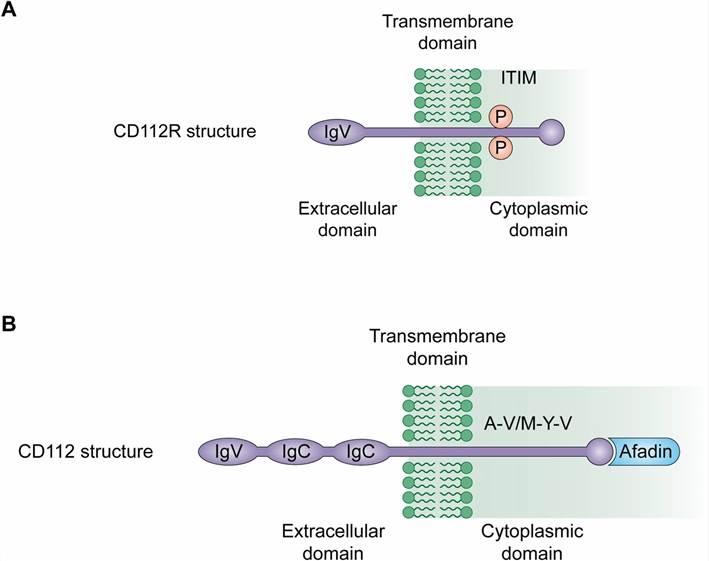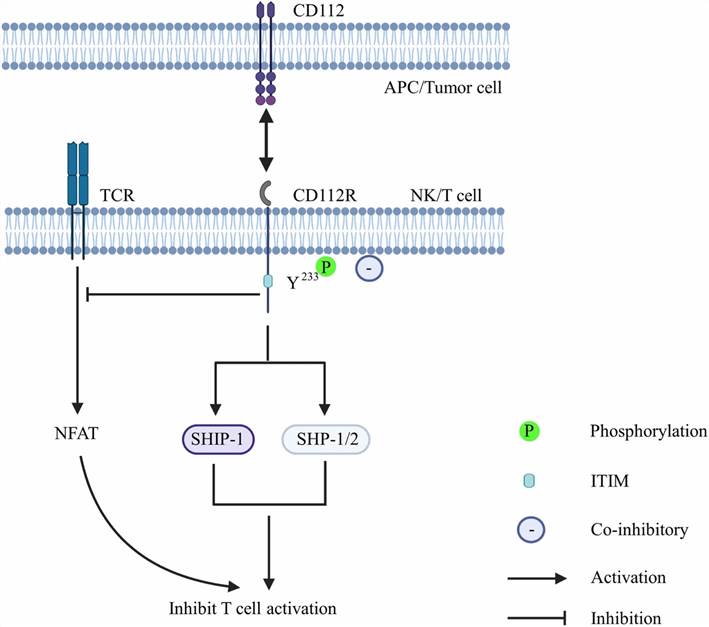Poliovirus receptor-related immunoglobulin domain-containing protein (PVRIG, also named CD112R), has been identified as an inhibitory immune checkpoint molecule that has strong interaction with poliovirus receptor-related 2 (PVRL2, also termed as CD112 /Nectin-2), mediating a co-inhibitory signal that blocks T cell activation or proliferation.
PVRIG is a 36-kD transmembrane monomer, consisting of a single extracellular IgV domain, a transmembrane domain, and a long intracellular domain. These domains contain residues that are conserved among the PVR family, composing two tyrosine phosphorylation sites, including an ITIM-like motif.
 Fig.1 CD112R and CD112 structures.1,3
Fig.1 CD112R and CD112 structures.1,3
PVRIG is expressed by natural killer (NK) cells and T cells (predominantly CD8+ T cells) in human PBMCs, and also in numerous solid tumors. It binds to the single ligand PVRL2, recruiting SHP1 and SHP2 that trigger the inhibition of the TCR/CD28 signaling in T cells and exerting an inhibitory effect on cytotoxic lymphocyte activity. PVRIG interacts with PVRL2 competing with DNAM-1 but not with PVR (CD155). It has been reported that blocking the PVRIG - PVRL2 axis increases effector T-cell function in cancer, suggesting that the PVRIG - PVRL2 and PVR-TIGIT pathways could be non-redundant inhibitory signaling pathways, suppressing cytokine production and cytotoxic activity.
PVRIG has been noticed as an immune checkpoint molecule with potential for drug development. It was demonstrated in breast cancer that antibodies blocking PVRIG could enhance antibody-mediated NK cell response, thus significantly increasing the cytotoxicity of NK cells against cancer cell lines in vitro. Besides, in the presence of surface-bound anti-CD3 antibodies expressed by an allogeneic melanoma cell line, PVRIG blockade alone or combined with PD-1 blockade or TIGIT blockade is reported to upregulate cytokine production by tumor-infiltrating lymphocytes (TILs) from endometrial, lung tumors, and ovarian.
 Fig.2 Interaction between CD112R and its ligand leading to a decrease in T cell cytotoxicity.2,3
Fig.2 Interaction between CD112R and its ligand leading to a decrease in T cell cytotoxicity.2,3
Currently, there are several anti-PVRIG antibody drugs in ongoing clinical trials, administered alone or in combination with anti-TIGIT ICI in several solid tumors, and PVRIG blockade is also being evaluated with PVRIG inhibitor alone or in combination with PD-1 blockade. There are also preclinical trials in promising cancer targets of PVRIG, including single blockage of PVRIG treatment for breast cancer by enhancing NK cells activity, and blockade of PVRIG in combination with TIGIT or PD-1 blockade treatment for melanoma, pancreatic cancer by increasing CD8+ T-cell function.
With sufficient experience and proven R & D capabilities, Creative Biolabs provides professional immune checkpoint drug development services. Our technology platforms offer a full range of PVRIG immune checkpoint molecule drug development services, including but not limited to:
If you are interested in any one of our services, please do not hesitate to contact us for more detailed inquiries.
References
All listed customized services & products are for research use only, not intended for pharmaceutical, diagnostic, therapeutic, or any in vivo human use.
USA
Tel:
Fax:
Email:
Copyright © 2026 Creative Biolabs. All Rights Reserved.